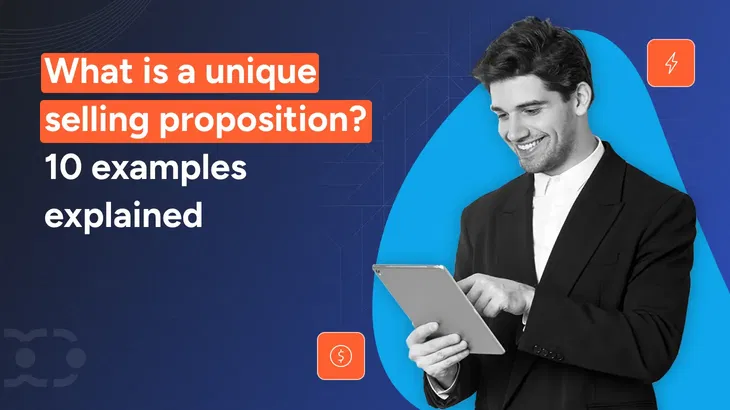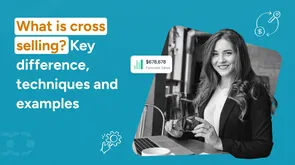-> Lead on with the USP
The unique selling proposition should always be a unique you for your product.
Being a business owner, you should know your unique selling proposition should define the strengths and benefits of the product/service that will help distinguish your product from competitors.
-> Present your unique points correctly
Always remember that your USP should include you and your company. You are showcasing yourself, your product/service, and the enthusiasm and authenticity that shine you through in this competitive market.
If your USP is not unique, it might fail to attract a larger audience. A unique USP can inspire confidence in you and your product and intrigue customers to learn more about it.
-> Include a hyperbole
Including a hyperbole in your USP can effectively convey enthusiasm, confidence, and pride in your product or service. Using words like "only," "best," or "greatest" helps create a powerful and memorable impression, making your unique selling point stand out.
While it may feel overly sales, when backed by genuine product quality or results, hyperbole becomes a tool for emphasizing your unique value.
For instance, saying, "Our customers demand the best, and that's why they hire us" communicates a higher level of trust and excellence than a generic statement.
The key is to use hyperbole appropriately, ensuring it aligns with your product’s strengths and resonates with your audience.
-> Focus on the benefits it is giving to the customers
A compelling USP should focus on the benefits your customers will experience after purchasing, emphasizing how your product transforms their reality or solves the sales challenges.
Instead of simply showcasing features, highlight the value and outcomes your product or service promises to deliver.
-> Share the USP out loud
Sharing your USP out loud, whether over the phone or in person, allows you to communicate not just the words but also the confidence, tone, and enthusiasm behind them.
This personal delivery makes your marketing messages more impactful and engaging, helping prospects feel your conviction and belief in your product.
Start by understanding the needs of the sales team, then passionately explain how your unique selling proposition addresses their challenges and delivers value.
The strength of your delivery, combined with your genuine enthusiasm, helps build trust and makes your USP more compelling and memorable.
10 Unique selling proposition examples for businesses
A unique selling proposition (USP) defines what makes a business stand out from its competitors. Here are 10 notable unique selling proposition examples:
1) Hiut Denim
"We make jeans. That's it." Hiut Denim focuses solely on crafting high-quality jeans, emphasizing their dedication and expertise in this niche, which is the best unique selling proposition example.
2) Death Wish Coffee
"The world's strongest coffee." This brand appeals to coffee enthusiasts seeking a high-caffeine blend, setting itself apart in the crowded coffee market.
3) Toms Shoes
"One for One." Tom's pledges to donate shoes to a child in need for every pair sold, integrating social responsibility into their business model.
4) FedEx
"When it absolutely, positively has to be there overnight," FedEx emphasizes its reliable overnight shipping service, appealing to customers needing fast delivery.
5) M&M's
"Melts in your mouth, not in your hand." This USP highlights the candy's unique hard shell that prevents melting, differentiating it from other chocolates.
6) Domino's Pizza (1973-1993)
"You get fresh, hot pizza delivered to your door in 30 minutes or less or it's free." Dominos built its reputation on speedy delivery, catering to customers seeking quick service.
7) Head & Shoulders
"Clinically proven to reduce dandruff." This USP highlights the shampoo's effectiveness in treating dandruff, appealing to consumers seeking a reliable solution.
8) Southwest Airlines
"We are THE low-fare airline." Southwest positions itself as the go-to airline for budget-conscious travelers.
9) Robinhood
"Investing for everyone." Robinhood's USP centers on making financial markets accessible to all, eliminating traditional barriers to an online retailer.
10) Zoom
"Video conferencing that doesn't suck," Zoom emphasizes its user-friendly, reliable video conferencing experience, standing out in a market often plagued by technical issues.
Wrap up!
"Your USP in action"
Now that you have mastered crafting a powerful, unique selling proposition, it is time to apply it to branding and marketing decisions.
Remember!
Your USP is not just a statement. It is the backbone of your sales strategy and the promise your brand delivers.
Use it to spark conversations, address your prospect's needs, and paint a picture of the success they'll achieve with your product.
Let your USP shine confidently and authentically, whether you share it in person or align it across your marketing channels.
Remember that your USP evolves as your audience grows and market demands shift, so keep refining it to stay relevant and impactful.
Also, remember to use a CRM automation tool to peak your sales and profits.







Key takeaways
What sets a product apart? No, take a moment to think about it.
How will you answer the same question when you are in front of a potential customer? Why should the customer take your product instead of your competitor's?
Do you stumble while searching for the right words or deliver a confident and clear response that will make them say, "Yes, I need this product?"
That clarity and confidence come from having a rock-solid, unique selling proposition (USP).
In this blog, we will learn about:
So, let's begin with the meaning.
What is unique selling proposition?
A unique selling proposition is an attribute of your product or brand that sets itself apart from the competitors and explains why it is the best solution for the customer's needs.
It reflects the brand values, highlighting distinct benefits and answering the question, 'What does my business offer that is different?'
USPs are tailored to specific aspects, often used early in the sales process, and designed to resonate personally with the audience being addressed.
What is the importance of unique selling proposition (USP) in your business?
Only 3% of the market audience buys products at the perfect time. That's why a unique selling proposition plays an effective role, but how do you find out your business USP:
1) Market research your competition
If you are willing to know the USP of your competitors, then carry out thorough market research into competitors. Here is how you can do the same:
2) Identify the prominent differentiators
To identify the prominent differentiators of your product or service based on the content:
For example:
- Proprietary technology or exclusive features.
- Tailored solutions designed for niche markets.
- Results-oriented benefits, such as faster performance or improved outcomes.
For instance:
- "Designed for busy professionals to save 20% more time in daily operations."
- "Simplifies complex tasks into three easy steps."
For example:
- "Eliminates the need for manual follow-ups with smart automation."
- "Built for first-time users with an intuitive, zero-training interface."
For example:
- Superior durability or extended product lifespan.
- Exceptional customer service backed by data-driven insights.
For example:
- "Sustainably crafted with 100% recycled materials."
- "Powered by a diverse team of experts who understand real-world challenges."
3) Understanding the customer needs
To create a strong, unique selling proposition, aligning your unique attributes with your audience's true values is essential.
Start by identifying their needs and pain points through research, whether it's faster delivery, simple tool setup, or better customer support stands apart.
Next, analyze competitors to uncover product gaps, such as lack of personalization or weak customer support service.
Then, position your strengths to directly address these unnecessary needs in ways competitors cannot easily replicate, like offering intuitive designs or personalized onboarding.
Finally, refine your USP through prospective customers' feedback to ensure it resonates and stays relevant.
4) Writing the perfect statement
To craft a perfect, unique selling proposition (USP), start with a clear formula:
"[Your brand] offers [product or service] for [target market] to [value proposition]. Unlike [the alternative], we [key differentiator]."
A well-crafted USP ensures your brand resonates with your target audience while standing out from competitors' brand stand.
Begin your automation journey post USP identification!
Salesmate can help identify and manage your entire sales, marketing, and customer service teams quickly.
How to write a unique selling proposition?
23.2% of businesses tend to fail within the first year of operations in the USA as they did not find a standout factor from their competitors.
That's why having and writing a compelling USP from starting makes it easier for businesses to survive:
-> Lead on with the USP
The unique selling proposition should always be a unique you for your product.
Being a business owner, you should know your unique selling proposition should define the strengths and benefits of the product/service that will help distinguish your product from competitors.
-> Present your unique points correctly
Always remember that your USP should include you and your company. You are showcasing yourself, your product/service, and the enthusiasm and authenticity that shine you through in this competitive market.
If your USP is not unique, it might fail to attract a larger audience. A unique USP can inspire confidence in you and your product and intrigue customers to learn more about it.
-> Include a hyperbole
Including a hyperbole in your USP can effectively convey enthusiasm, confidence, and pride in your product or service. Using words like "only," "best," or "greatest" helps create a powerful and memorable impression, making your unique selling point stand out.
While it may feel overly sales, when backed by genuine product quality or results, hyperbole becomes a tool for emphasizing your unique value.
For instance, saying, "Our customers demand the best, and that's why they hire us" communicates a higher level of trust and excellence than a generic statement.
The key is to use hyperbole appropriately, ensuring it aligns with your product’s strengths and resonates with your audience.
-> Focus on the benefits it is giving to the customers
A compelling USP should focus on the benefits your customers will experience after purchasing, emphasizing how your product transforms their reality or solves the sales challenges.
Instead of simply showcasing features, highlight the value and outcomes your product or service promises to deliver.
-> Share the USP out loud
Sharing your USP out loud, whether over the phone or in person, allows you to communicate not just the words but also the confidence, tone, and enthusiasm behind them.
This personal delivery makes your marketing messages more impactful and engaging, helping prospects feel your conviction and belief in your product.
Start by understanding the needs of the sales team, then passionately explain how your unique selling proposition addresses their challenges and delivers value.
The strength of your delivery, combined with your genuine enthusiasm, helps build trust and makes your USP more compelling and memorable.
10 Unique selling proposition examples for businesses
A unique selling proposition (USP) defines what makes a business stand out from its competitors. Here are 10 notable unique selling proposition examples:
1) Hiut Denim
"We make jeans. That's it." Hiut Denim focuses solely on crafting high-quality jeans, emphasizing their dedication and expertise in this niche, which is the best unique selling proposition example.
2) Death Wish Coffee
"The world's strongest coffee." This brand appeals to coffee enthusiasts seeking a high-caffeine blend, setting itself apart in the crowded coffee market.
3) Toms Shoes
"One for One." Tom's pledges to donate shoes to a child in need for every pair sold, integrating social responsibility into their business model.
4) FedEx
"When it absolutely, positively has to be there overnight," FedEx emphasizes its reliable overnight shipping service, appealing to customers needing fast delivery.
5) M&M's
"Melts in your mouth, not in your hand." This USP highlights the candy's unique hard shell that prevents melting, differentiating it from other chocolates.
6) Domino's Pizza (1973-1993)
"You get fresh, hot pizza delivered to your door in 30 minutes or less or it's free." Dominos built its reputation on speedy delivery, catering to customers seeking quick service.
7) Head & Shoulders
"Clinically proven to reduce dandruff." This USP highlights the shampoo's effectiveness in treating dandruff, appealing to consumers seeking a reliable solution.
8) Southwest Airlines
"We are THE low-fare airline." Southwest positions itself as the go-to airline for budget-conscious travelers.
9) Robinhood
"Investing for everyone." Robinhood's USP centers on making financial markets accessible to all, eliminating traditional barriers to an online retailer.
10) Zoom
"Video conferencing that doesn't suck," Zoom emphasizes its user-friendly, reliable video conferencing experience, standing out in a market often plagued by technical issues.
Wrap up!
"Your USP in action"
Now that you have mastered crafting a powerful, unique selling proposition, it is time to apply it to branding and marketing decisions.
Remember!
Your USP is not just a statement. It is the backbone of your sales strategy and the promise your brand delivers.
Use it to spark conversations, address your prospect's needs, and paint a picture of the success they'll achieve with your product.
Let your USP shine confidently and authentically, whether you share it in person or align it across your marketing channels.
Remember that your USP evolves as your audience grows and market demands shift, so keep refining it to stay relevant and impactful.
Also, remember to use a CRM automation tool to peak your sales and profits.
Frequently asked questions!
1) Why does a business analyze and identify its unique selling proposition?
It is crucial to identify and analyze the unique selling proposition because it is:
2) What benefits does a USP offer a business?
The unique selling proposition (USP) offers several benefits, including:
3) What are the six steps in the process of creating a USP?
The creation of a compelling, unique selling point involves the following six steps:
4) Can a business have multiple USPs?
Yes, a business can simultaneously have multiple unique selling points, but these tend to be tailored to specific products, services, or target audiences.
While businesses may have one overarching USP that tends to define the brand, individual offerings can have unique selling points that highlight their distinct features or benefits with brand highlights.
5) What is USP in marketing?
In marketing, a unique selling point (USP) is a clear statement that defines what makes a product, service, or brand distinct from its competitors to make your own USP.
It highlights the unique benefits or features that persuade customers to choose one offering over another. A well-crafted USP effectively communicates a brand's unique value, setting it apart from other brands.
Hinal Tanna
SEO SpecialistHinal Tanna is a SEO strategist and content marketer, currently working with the marketing team of Salesmate. She has a knack for curating content that follows SEO practices and helps businesses create an impactful brand presence. When she's not working, Hinal likes to spend her time exploring new places.